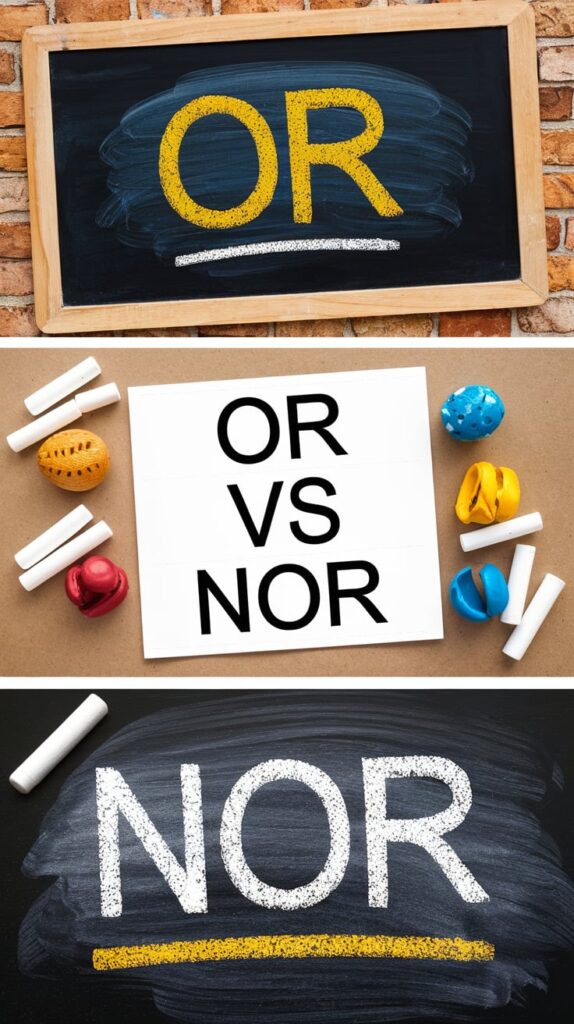Understanding the nuances between “or” and “nor” is essential for clear and effective communication. These two conjunctions might seem similar, but they serve distinct purposes in the English language.
This article dives deep into “or vs nor: what’s the difference and when to use each?”, providing rich examples and insights, especially focusing on their usage in various past tense scenarios.
read more : What Does Compare and Contrast Mean? – Grammar Beacon
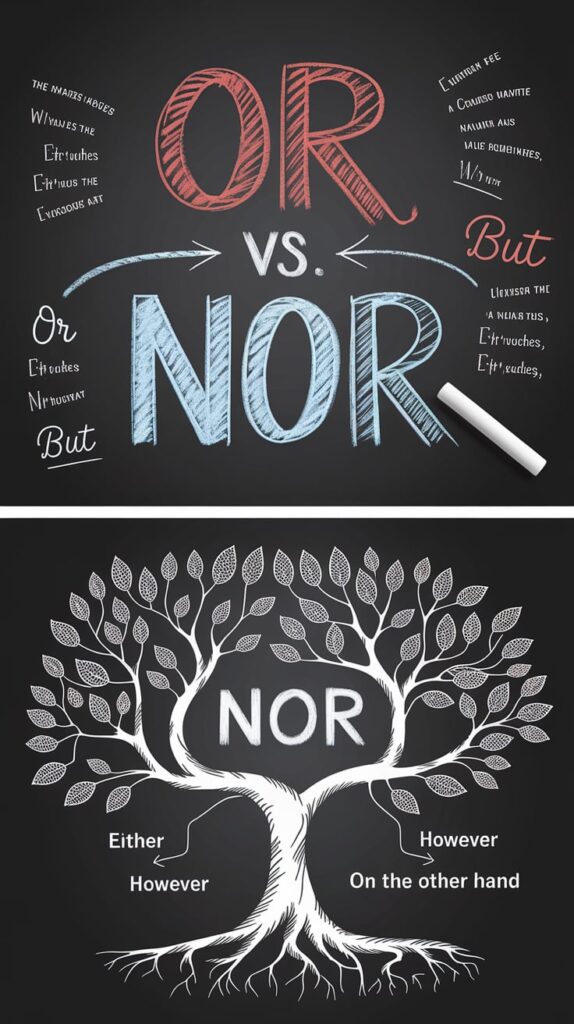
Understanding “Or”
Presenting Choices with “Or”
The primary function of “or” is to present choices. When you offer alternatives, you invite decision-making. For example:
Example: “Last weekend, I could either watch a movie or read a book.”
In this instance, the speaker had two choices, showcasing the typical use of “or.”
Indicating Possibilities with “Or”
Another critical role of “or” is to indicate possibilities.
Example: “She believed it could rain or snow during our trip last winter.”
Here, the speaker presents various possibilities regarding the weather, demonstrating the versatility of “or.”
read more : “Totalling” vs. “Totaling”: Navigating the Spelling Dilemma – Grammar Beacon
Offering Conditions with “Or”
“Or” can also introduce conditions, often framing scenarios that lead to specific outcomes.
Example: “You could leave early or risk getting stuck in traffic.”
In this case, leaving early serves as a condition to avoid a negative consequence.
Connecting Synonyms or Related Words with “Or”
Using “or” helps in linking synonyms or closely related terms.
Example: “He’s recognized for his creativity or innovation.”
This not only enhances clarity but also adds depth to the statement.
read more : Cacoon vs Cocoon Spelling – Grammar Beacon
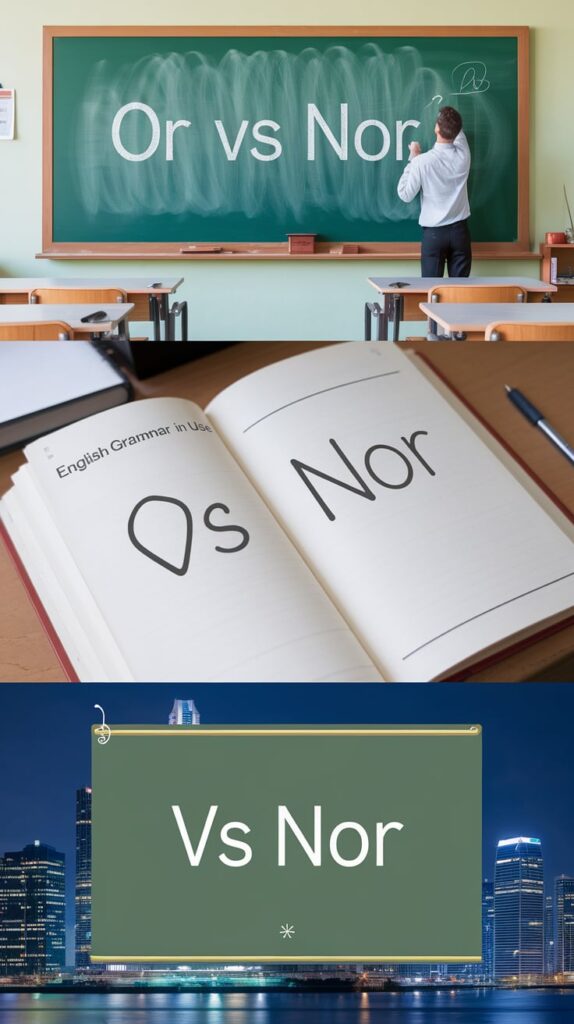
Understanding “Nor”
Combining Negative Statements with “Nor”
“Nor” primarily connects negative statements. It often follows “neither,” reinforcing the absence of options.
Example: “He neither called nor sent an email regarding the meeting.”
This construction makes it clear that both actions did not occur, effectively using “nor.”
Avoiding Redundancy with “Nor”
Using “nor” can help avoid redundancy in negative contexts.
Example: “She didn’t attend the event, nor did she participate in the discussions.”
This structure efficiently links two negative outcomes without unnecessary repetition.
Continuing Negative Comparisons with “Nor”
You can use “nor” to maintain the negative tone across comparisons.
Example: “The proposal was neither feasible nor affordable.”
This sentence emphasizes that both aspects are unsatisfactory, illustrating how “nor” functions in this context.
Starting Sentences for Emphasis with “Nor”
In formal writing, starting sentences with “nor” can add emphasis to a negative point.
Example: “Nor did the results align with our expectations.”
This emphasizes the negative outcome and underscores the importance of the statement.
read more : the Past Tense of See :Saw and Seen – Grammar Beacon
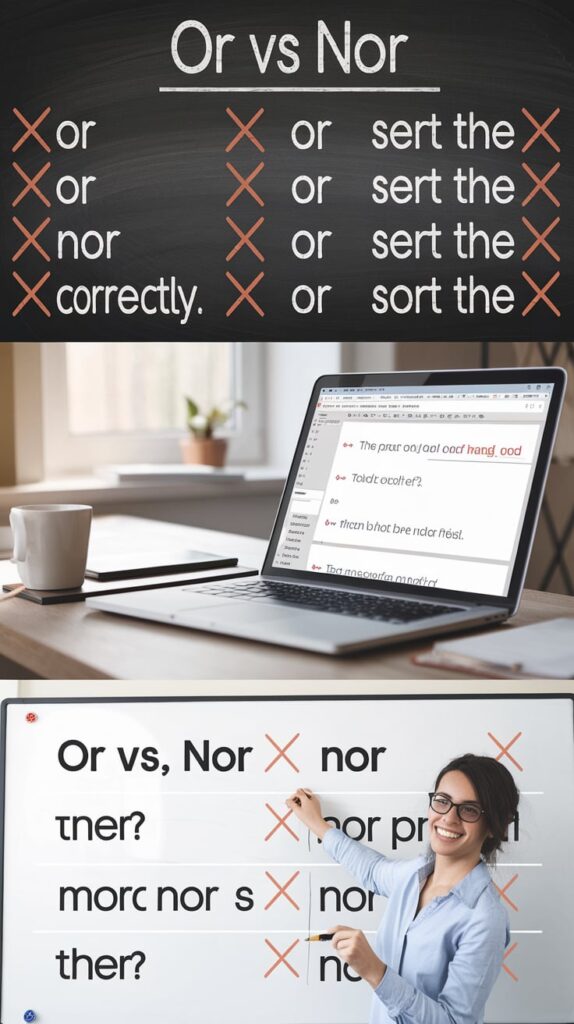
“Or” vs “Nor”: The Differences
Context of Use in “Or vs Nor”
The most significant distinction between “or” and “nor” lies in their context. “Or” operates in positive or neutral contexts, while “nor” is used exclusively in negative contexts. This understanding is crucial for correct usage.
Sentence Structure in “Or vs Nor”
- “Or”: Typically straightforward, linking two alternatives or possibilities.
- “Nor”: Often follows a negative statement, requiring a careful structure to maintain clarity.
Expressing Choices vs. Exclusions in “Or vs Nor”
“Or” expresses choices and alternatives, whereas “nor” indicates exclusions.
- Example with “or”: “Would you like coffee or tea?”
- Example with “nor”: “I want neither coffee nor tea.”
This difference is fundamental when crafting sentences.
Formality and Tone in “Or vs Nor”
Using “nor” generally adds a more formal tone compared to the casual nature of “or.”
Example: “The results were neither satisfactory nor conclusive” sounds more formal than “The results weren’t satisfactory or conclusive.”
Understanding the tone is essential for effective communication.
Common Mistakes to Avoid When Using “Or” or “Nor”
Incorrect Pairings in “Or vs Nor”
Avoid confusing “or” and “nor.”
- Incorrect: “She didn’t like ice cream or cake.”
- Correct: “She liked neither ice cream nor cake.”
This distinction is vital for clarity.
Replacing “Nor” with “Or”
Never substitute “nor” for “or” when linking negative clauses.
Missing Inversion with “Nor”
In formal contexts, remember that “nor” often requires subject-verb inversion.
Example: “He didn’t arrive on time, nor did he inform us.”
This structure reinforces the negative tone effectively.
Redundant Usage in “Or vs Nor”
Be cautious of redundancy. Phrases like “neither…or” can confuse readers.
- Correct: “She likes neither cats nor dogs.”
- Incorrect: “She likes neither cats or dogs.”
Inconsistent Usage in “Or vs Nor”
Maintain consistency in your writing. Switching between “or” and “nor” can disrupt flow and clarity.
Improper Use in Lists with “Or” or “Nor”
When creating lists, ensure “nor” follows a preceding negative statement.
- Correct: “He enjoys neither hiking nor biking.”
- Incorrect: “He enjoys hiking nor biking.”
Using “Or” and “Nor” in Sentences
Using “Or” in Sentences
- “Would you like to go for a walk or stay at home?”
- “You can have pizza or pasta for dinner.”
- “She can choose to study abroad or find a local internship.”
Using “Nor” in Sentences
- “He neither studied for the exam nor did he complete his homework.”
- “The restaurant offers neither vegetarian nor gluten-free options.”
- “They didn’t visit the museum, nor did they go to the park.”
Origins of “Or” and “Nor”
Origins of “Or”
“Or” has its roots in Old English as “oþþe,” evolving from Proto-Germanic. Its function as a conjunction has remained consistent throughout its history, facilitating the expression of choices and alternatives.
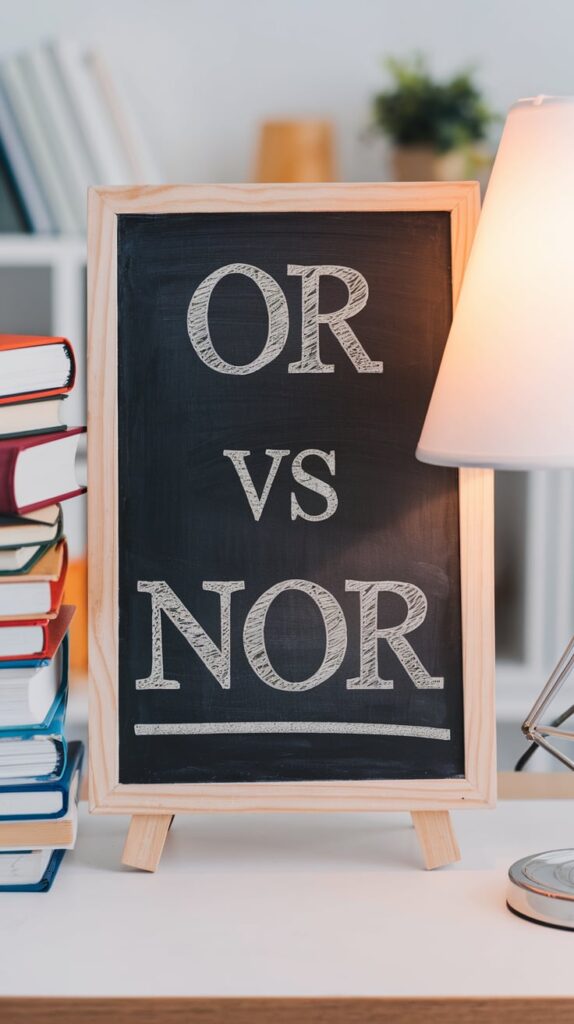
Origins of “Nor”
“Nor” emerged in Middle English as a combination of “ne” (not) and “or.” This unique formation allows it to link negative statements effectively.
A Final Look at “Or” vs “Nor”
In conclusion, understanding “or vs nor: what’s the difference and when to use each?” can significantly enhance your communication.
Use “or” for presenting choices, possibilities, and conditions, while reserve “nor” for connecting negative statements and exclusions.
By avoiding common pitfalls and applying these insights, you’ll be better equipped to convey your thoughts clearly and effectively. Embrace these conjunctions, and watch your writing improve!
Additional Scenarios with Past Tense
Using “Or” in Past Tense Scenarios
- Presenting Choices: “Last summer, I had to choose between hiking or camping.”
- Indicating Possibilities: “He thought the movie might be good or just another cliché.”
- Offering Conditions: “If it was too hot, we could go swimming or stay indoors.”
Using “Nor” in Past Tense Scenarios
- Combining Negative Statements: “She neither visited her friends nor called them during the holidays.”
- Avoiding Redundancy: “He didn’t finish his project on time, nor did he submit it.”
- Continuing Negative Comparisons: “The weather was neither sunny nor warm last week.”
Expanding on Usage and Context
Understanding how to use “or” and “nor” effectively involves not only recognizing their basic functions but also applying them in various contexts. Let’s explore more examples that illustrate their use in everyday communication.

Everyday Scenarios with “Or”
- Decision-Making: “Do you want to go out for dinner or cook at home?” This example showcases how “or” can frame a personal decision, highlighting the speaker’s options.
- Social Situations: “Should we go to the party or just relax at home?” Here, “or” presents two different social choices, making it easy for the listener to weigh the options.
Everyday Scenarios with “Nor”
- Clarifying Exclusions: “He didn’t like jazz music, nor did he appreciate classical.” This example emphasizes the speaker’s definitive stance on both music genres, linking two negative preferences seamlessly.
- Building Context: “They hadn’t planned any trips, nor had they saved money for vacations.” This demonstrates how “nor” can connect multiple negative statements effectively, enhancing the narrative.
Practical Applications in Writing
Understanding the distinctions between “or” and “nor” also benefits your writing style. Here are some tips on how to apply these conjunctions effectively:
Tips for Using “Or”
- Be Clear: When presenting choices, ensure that your options are clear and distinct. For example, “You can take the bus or the train.” 2
. Use Commas Wisely: In complex sentences, use commas to separate options. “You can choose a dessert, like cake or ice cream, after dinner.”
Tips for Using “Nor”
- Emphasize Negativity: When using “nor,” consider starting the sentence for emphasis. For instance, “Nor did she ever return my calls.”
- Combine with “Neither”: Using “nor” after “neither” reinforces a negative statement effectively. “He neither confirmed nor denied the allegations.”
Analyzing Nuances in Context
To further enhance your grasp of “or” and “nor,” let’s delve into some nuanced contexts where their usage may vary.
Exploring Complex Sentences
- Using “Or”: “You could have chosen to study psychology or sociology, but you opted for history instead.” This sentence showcases how “or” can weave choices into a more complex narrative.
- Using “Nor”: “She had neither the time nor the inclination to join the committee.” This illustrates how “nor” maintains a consistent negative tone in a layered sentence.
Conditional Statements
“Or” can frame conditional statements effectively, influencing the direction of the conversation.
- Example: “If you finish your work early, we can go to the movies or grab dinner afterward.” Here, “or” helps outline potential outcomes based on the condition presented.
Conversely, “nor” can clarify the negative aspects of conditions:
- Example: “He couldn’t participate in the game, nor could he join the practice sessions.” This sentence underlines the absence of both options, emphasizing his limitations.
Conclusion: Mastering the Usage of “Or” and “Nor”
Mastering the distinctions between “or” and “nor” enriches your writing and enhances your ability to communicate effectively. As you continue to practice these conjunctions, remember:
- Use “or” for positive choices, possibilities, and alternatives.
- Use “nor” for negating options, linking negative statements, and emphasizing exclusions.
By incorporating these insights into your daily communication and writing, you’ll not only improve your grammatical accuracy but also enhance the clarity and impact of your messages. Embrace these tools, and your proficiency in English will flourish!
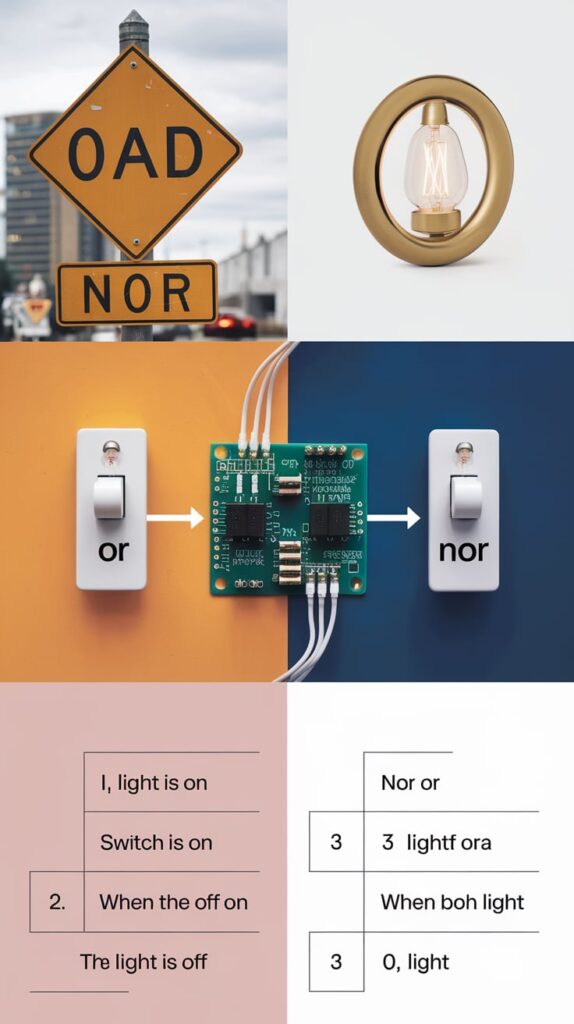
Additional Sources
With practice and awareness, you’ll navigate the realms of “or” and “nor” like a pro!

James Logan is a seasoned blogger and language enthusiast behind Grammar Beacon. With years of experience in grammar and writing, James shares his expertise through insightful and engaging content. His passion for clear communication and linguistic precision shines in every post, making complex grammar concepts accessible and enjoyable for readers. Follow James for expert advice and tips to refine your writing skills.

